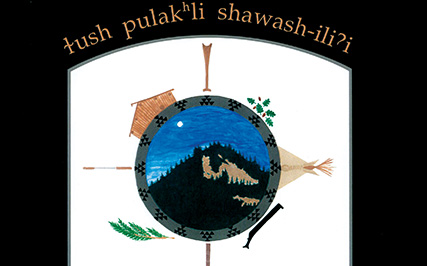Culture
Language staff publish book in Chinuk Wawa

It is evening in Grand Ronde and approximately 30 to 40
pre-kindergarten through third-graders in Chinuk Wawa immersion
classes and their families meet in the gym, or the plankhouse, for
an evening of language fun called Chinuk Literacy Night.
Before the evening activity was over last November, they were all
saying, "Goodnight, Grand Ronde."
"For Literacy Night," said Ali Holsclaw, Chinuk Immersion teacher,
"we always pick a book (already published), read it aloud and every
family goes home with a copy.
"We would buy books easy to translate," she added, and before
Literacy Night language teachers translated the books into Chinuk
Wawa. They then pasted the Chinuk Wawa words over the English
ones.
For words that are not among the ones that have come down from the
Chinuk Wawa language, teachers have to either use the English word,
like they have in the case of spoon or pizza, and spell them
phonetically with Chinuk Wawa letters; or they have to make up a
word by piecing together Chinuk Wawa words that exist.
Take cell phone, for example. They turned it into "lima," which
means hand, and "tintin," which means sound or ring.
Starting last fall, that all changed. Literacy Night was scheduled
right around Restoration time and "we decided to have our own Grand
Ronde local story," Holsclaw said.
The program is working with a competitive three-year Administration
for Native Americans Esther Martinez language grant used for
kindergarten and first grade. The last three-year grant, averaging
$250,000 a year, ends at the end of July, said Tribal Planning and
Grants Development Manager Kim Rogers.
The program has won this competitive grant every year but one since
2001. A new rule, however, limits Tribes to only two wins in a row,
meaning that Grand Ronde cannot apply this year. Next year, said
Rogers, the Tribe will seek to win another ANA Esther Martinez
three-year grant that would start in August 2015.
The idea of publishing a Chinuk Wawa book focusing on Grand Ronde
moved the project forward. Next came the writing, illustrating and
publishing process. Holsclaw chose the book's model and wrote the
story.
Crystal Sczcepanski, Chinuk Wawa Language specialist and liaison,
and an excellent artist, illustrated it.
She said she used "a mix of professional and kid craft materials. I
used a variety of mediums: Acrylic, color pencils, watercolor
pencils, construction paper, poster paper, oil-based markers and
children's washable markers.
"It reminded me of how creative our recent ancestors were with
materials they had access to. I was just using ingenuity like my
great-grandmothers."
Esther Stewart, also a Chinuk Immersion teacher with a degree in
graphic design, put the book in the proper form and dealt with the
publisher.
"I set the book up in InDesign and did all of the layout work,"
Stewart said. "I was able to use Photoshop and InDesign programs to
scan, size and modify the images, and put them in a PDF file
format."
Stewart saved money by doing what any publisher would have charged
to do.
The first edition of 50 copies went to families at Literacy Night
in November. The book was so popular that the immersion program
ordered a second printing of 100 to raise money for other language
literacy activities.
The book was introduced to the community at the opening of
Chachalu/Summer Kick-Off on June 5. The department's first
published Chinuk Wawa book had sold about 10 copies by June
16.
"Goodnight Grand Ronde" (ɫush pulakʰli shawash-iliʔi) now sells for
$7 through Tiffany Mercier at the front desk in the Youth Education
building. It also is available at the Tribal Library.
The immersion program intends to continue writing, illustrating and
publishing Chinuk Wawa books for future Literacy Nights. With the
one-year gap in the grant funding, the program is going to have to
sell many books to keep the extra activities going.
